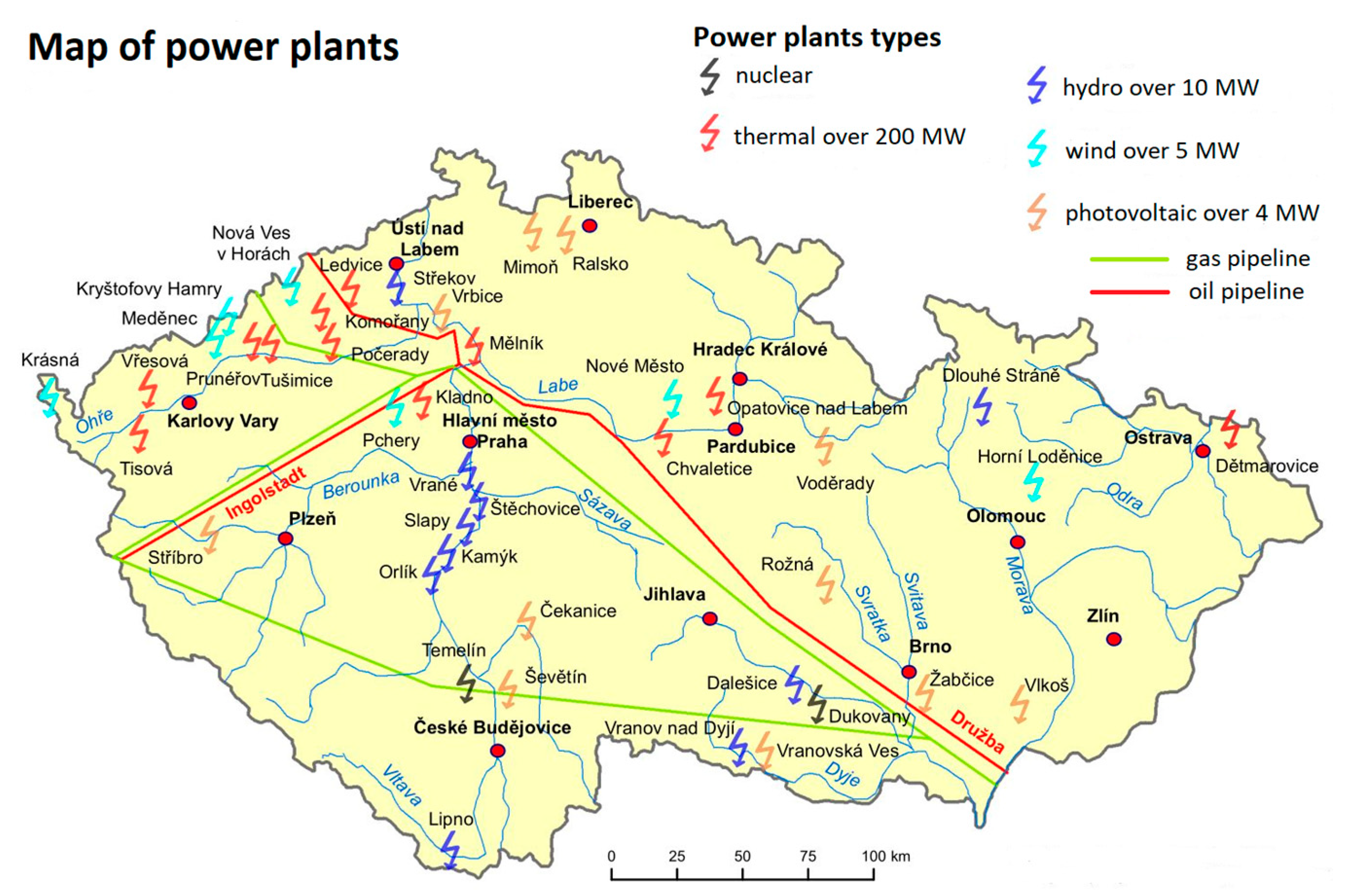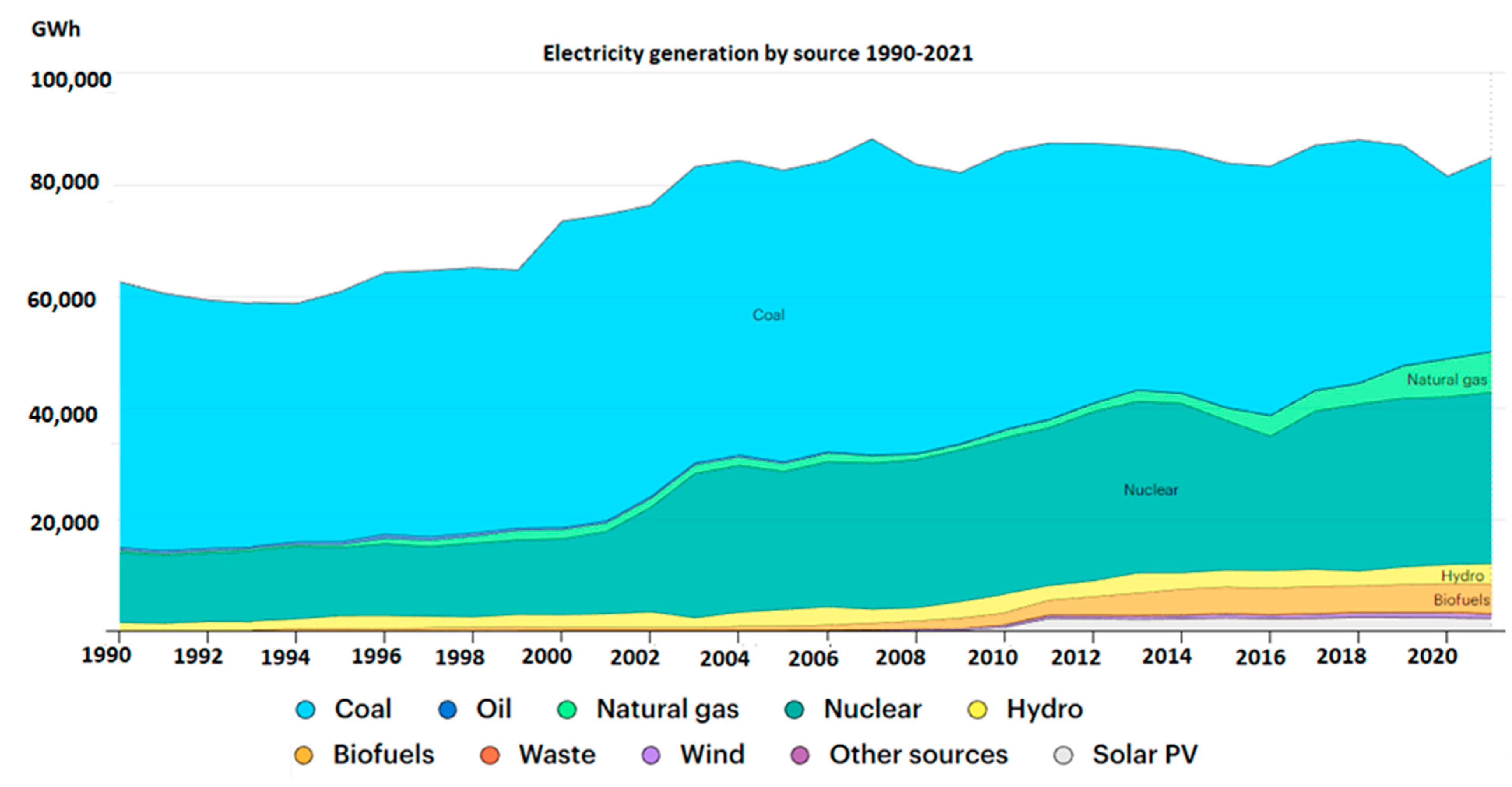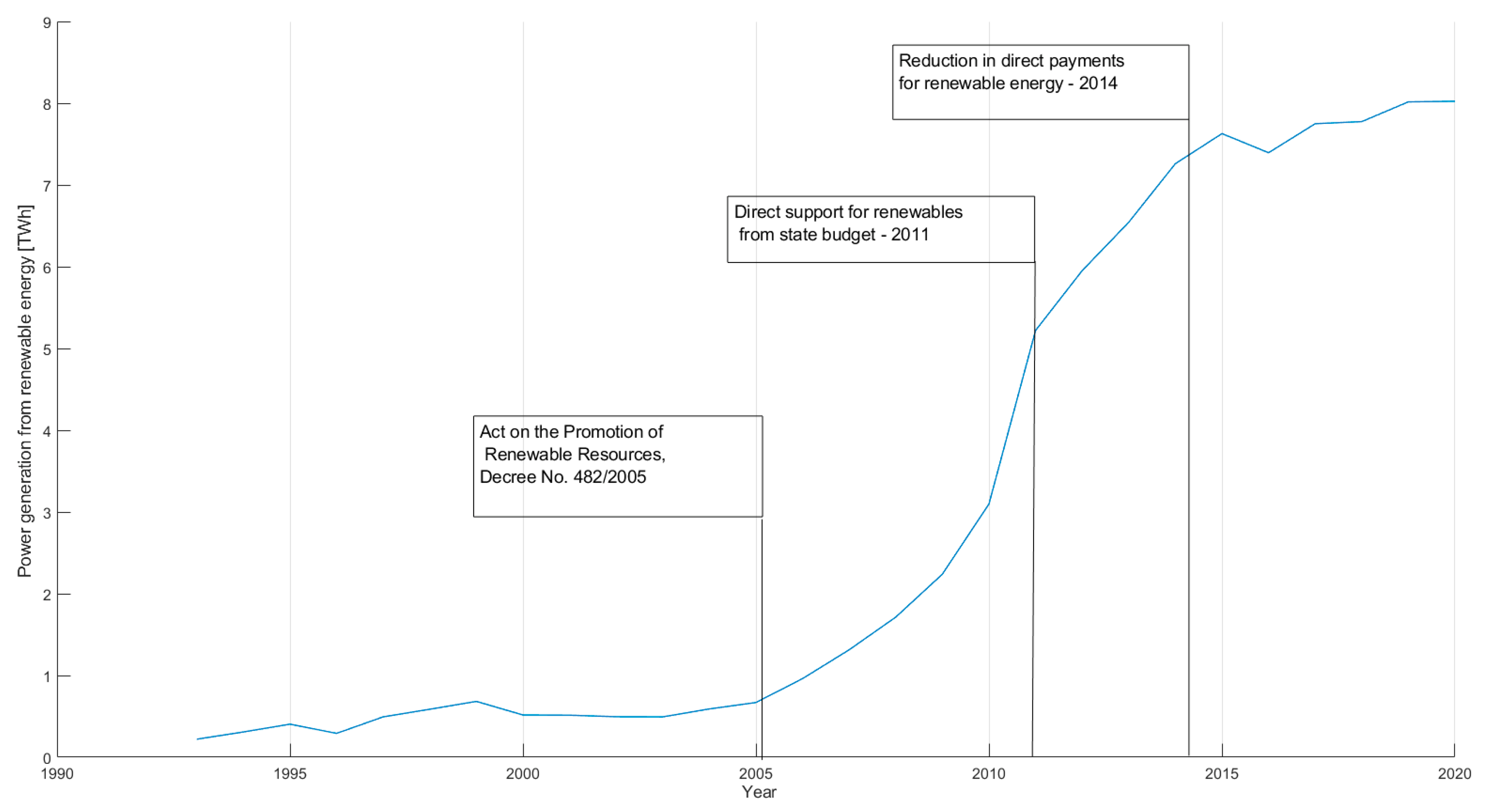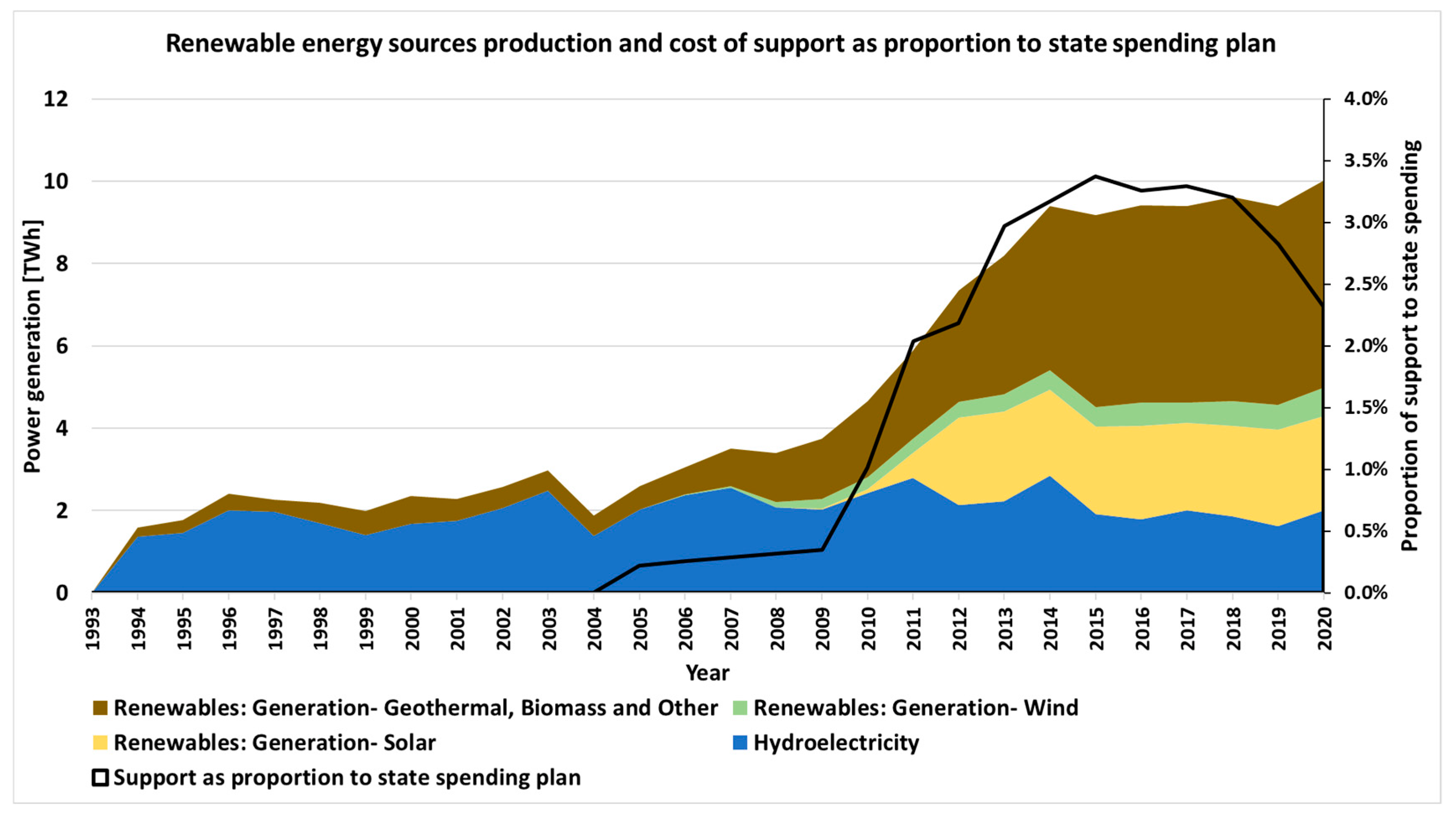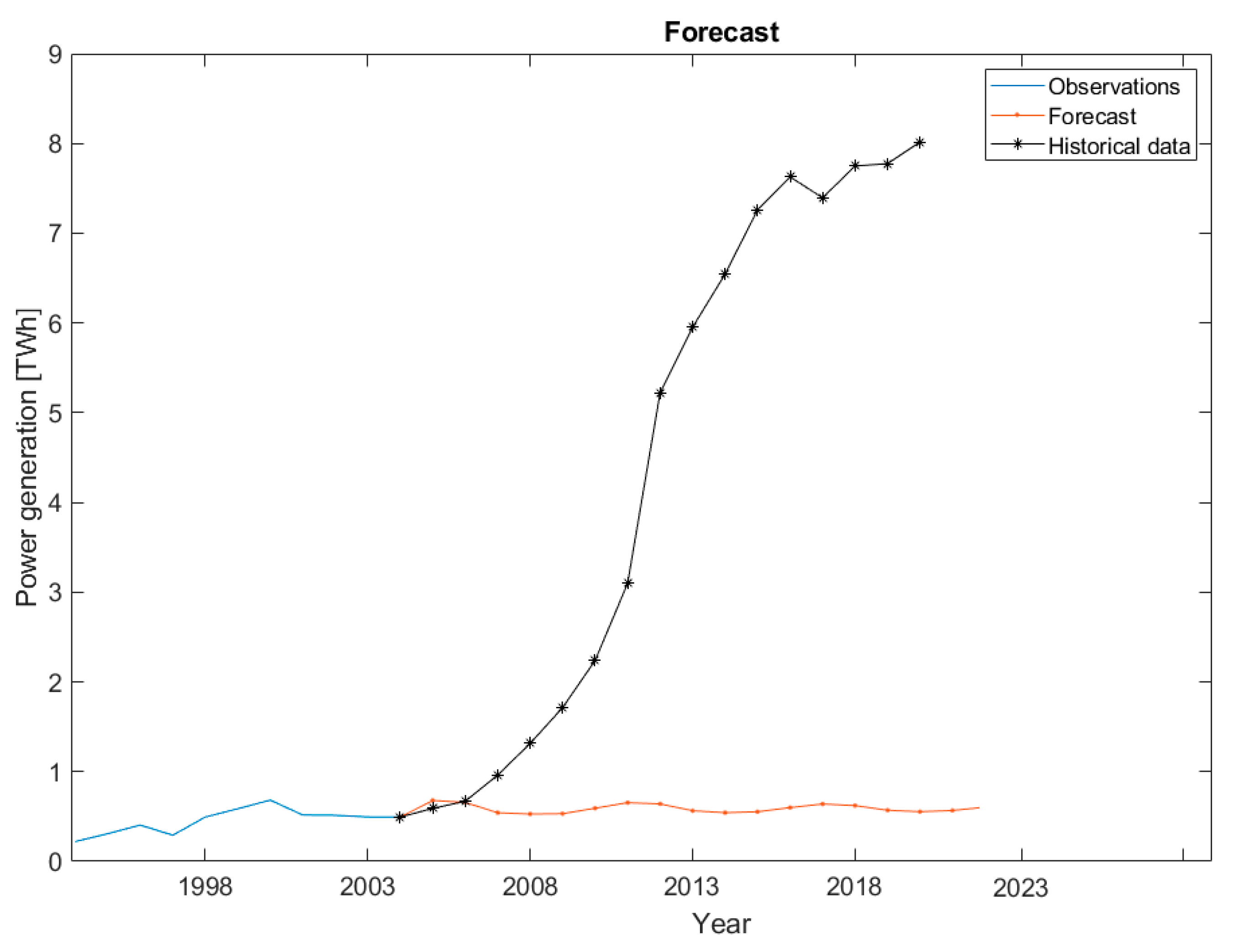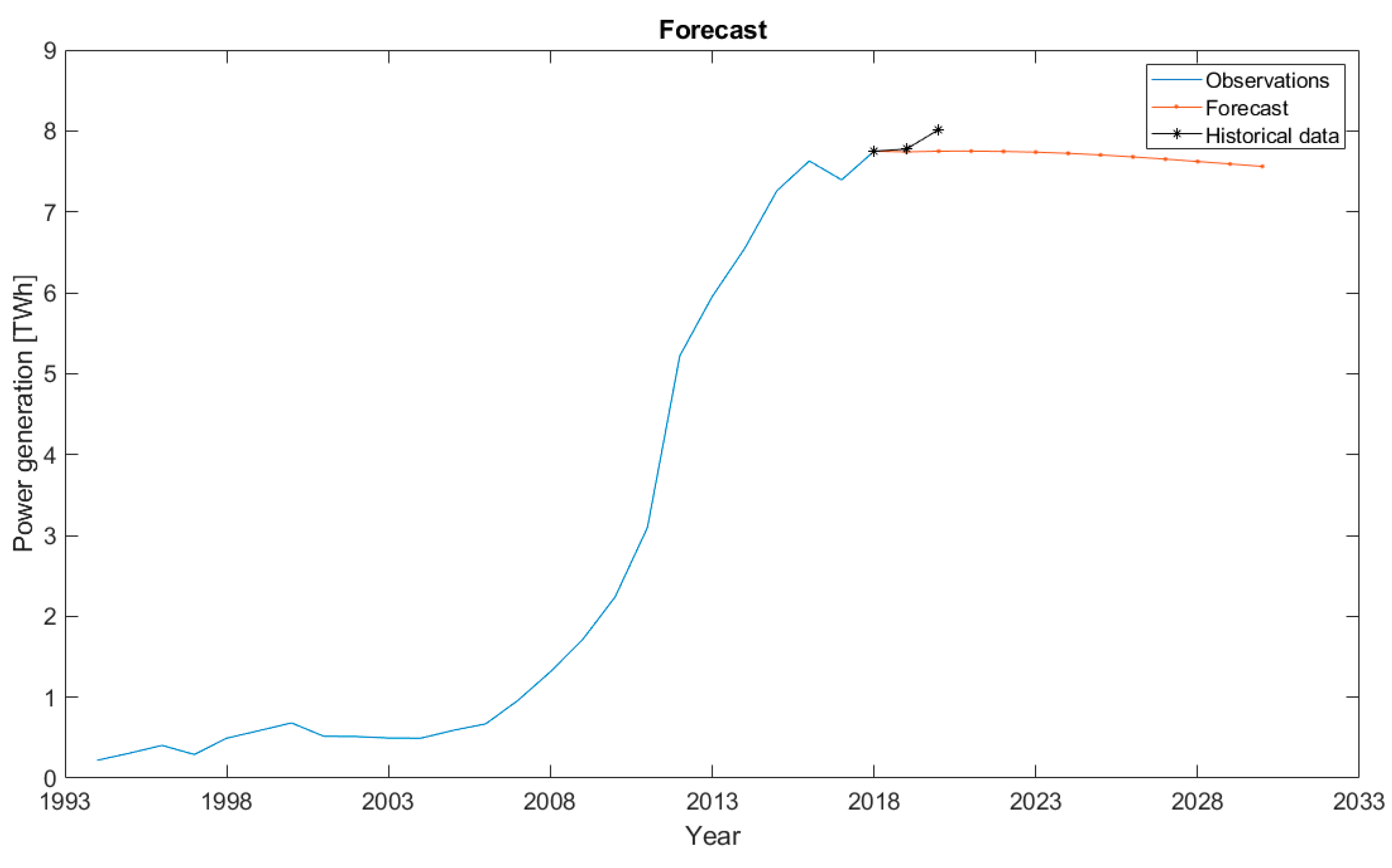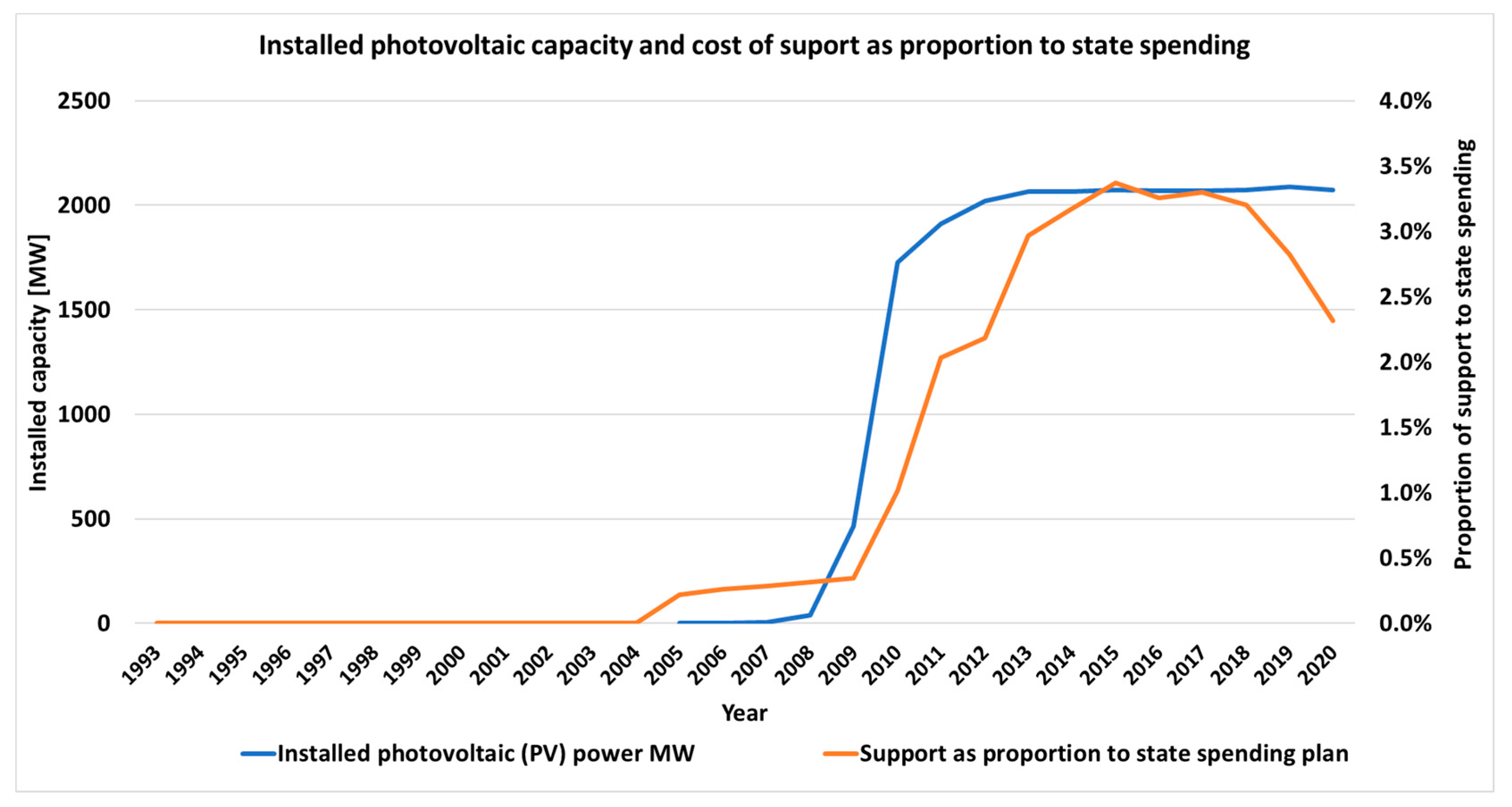1. Introduction
Historically, fossil fuels were the most important source of energy, and they continue to be the most essential component in the production of electricity, transportation, and the heating of homes and other buildings all across the world. Nuclear fuel, which is mostly used in electricity generation, is another important source of energy. These resources, however, are among those that significantly contribute to environmental contamination. CO
2 and other gases are emitted during the combustion of fossil fuels, and following the use of nuclear fuel, a significant amount of radioactive waste remains, which in most circumstances cannot be further processed, creating a problem with regard to its safe storage [
1].
There are many various sources of renewable energy available today, but solar energy can be regarded the foundation of almost all of them. In addition to solar energy, whether direct or turned into wind, water, and biomass energy, geothermal energy in the form of hot water springs or steam can be considered as a sustainable energy source.
The European Union, of which the Czech Republic has been a member since 1 May 2004, established the objectives of energy policy and sustainable development. The goal is to produce development that has no negative environmental impacts [
2].
In 1997, a document called the White Paper on Renewable Energy Sources was adopted, which formulated the concept of using alternative energy sources. The main goal was competitiveness, supply reliability, and environmental protection. The central factor was market integration [
3].
It defined a goal that mandates an increase in the share of energy from renewable sources in the EU. The document also contains an action plan. Individual member countries should increase the share of RES according to their own experience and potential [
4]. This goal is to be achieved in Czech Republic with tools developed by a team of authors, such as ensuring fair access of energy from renewable sources to the energy market, determining an adequate purchase price for energy from renewable sources, tax credits and exemptions for equipment using RES, preferential loans and subsidies for the construction of facilities for the use of renewable energy sources, and targeted promotion and green tariffs [
4,
5].
The Czech Republic must implement a number of measures as a result of its membership to the European Union and is required to follow the provided common European energy policy. The EU committed, at the entry time of the Czech Republic, to increasing the share of renewable energy sources in final consumption to 20% by 2020 [
6]. This aim was cut to 13% for the Czech Republic. Another significant reason to adopt RES is to reduce environmental damage, such as a drop in biodiversity and a decline in agricultural production. Another negative impact of solid fuel combustion is the influence on human health, which is a significant concern in the western part of the country [
6]. Other reasons for supporting RES include, for example, the reduction of climate change, which is helped by a significant reduction in greenhouse gas emissions that are not produced through RES [
6]. A basic overview of large power plants in the territory of the Czech Republic is shown in
Figure 1, that is based on [
7].
Directive 77/2001 EC is a foundational instrument for the Czech Republic’s support of renewable energy from RES. With the entry into the EU, this directive “Support for the production of electricity from renewable sources within the conditions of the single electricity market” was meant to be implemented in legislation [
5,
8]. In November 2003, the government received a draft bill to assist the generation of electricity and thermal energy from renewable energy sources, which was then sent to the Chamber of Deputies [
8].
The process was planned so that the law would be passed before the country joined the EU. Unfortunately, the debate was complex, and the bill was enacted in the Chamber of Deputies only after the union was formed. First and foremost, several fundamental concepts of the electricity production support system were changed, the section on heat support was removed, and a section detailing support for biofuels was added [
9,
10]. The majority of the recommendations and comments were created, considered, and then implemented. This is known as ER Decree No. 475/2005, which implements certain provisions of the Act on the Promotion of the Use of Renewable Resources, Decree No. 482/2005 Coll., on determining the types, methods of use, and parameters of biomass in support of the production of electricity from biomass, and ER Decree No. 502/2005 Coll., on determining the method of reporting the amount of electricity generated during the joint combustion of biomass and a nonrenewable source [
10].
The European concept of an overall energy strategy combines the fundamental requirements for reliable supply and long-term sustainability [
10]. This mostly refers to the urgent need to invest in order to fulfill the predicted demand for electricity and to replace aged infrastructure. Energy prices in the European Union have risen dramatically in recent years, putting consumers in a tough position. Natural gas and oil prices are expected to climb further due to rising global demand for fossil fuels, stretched supply systems, and increased reliance on imports. They can, however, serve as a catalyst for greater energy efficiency and innovation [
11,
12]. Our climate is still warming. Unless something is undertaken, warming of 1.4 to 5.8 degrees Celsius will occur by the end of the century [
1]. All parts of the world, including the European Union, will experience major economic and ecological implications. In Europe, fully competitive internal energy markets have yet to emerge [
13]. To do this, linkages must be built, effective legal and regulatory frameworks must be implemented properly, and compliance with Community competition laws must be firmly enforced. Furthermore, market forces should govern the integration of the energy sector if Europe is to effectively meet the numerous difficulties ahead and invest appropriately in the future [
14,
15].
Some energy production methods are more ecologically friendly than others. Nowadays, one of the most effective methods for producing electrical energy from nonrenewable resources is still used [
16]. However, despite their energy efficiency, they conceal a number of hazards. When coal, coke, and other fossil fuels are burnt, a considerable volume of exhaust gases escape into the atmosphere, polluting the environment and posing a significant risk to human health [
17]. For the Czech Republic, an overall review of energy sources used is shown in
Figure 2, based on [
18].
2. Support Mechanisms for the Use of Renewable Energy Sources
Technical and legal standards in the Czech Republic have the task of creating a framework for consumer and business entity behavior, implementing European Union legal regulations into the Czech legal system, and establishing the powers, functions, and conditions of activity of administrative and self-governing bodies in order to ensure environmental protection, human safety and health, and equal conditions for economic competition, including consumer protection. Energy legislation is made up of three major statutes: Law No. 458/2000 on business conditions and performance of state administration in energy sectors; Law No. 406/2000 about energy management; and Law No. 165/2012 about supported energy sources [
19].
Law No. 458/2000 was first adopted at 29.12.2000. The “Energy Act” is another public name for this Act. Its primary tasks include adjusting the circumstances for the production, transmission, and distribution of electricity and gas, as well as trading in these forms of energy. It also establishes the conditions for the production and distribution of thermal energy. Another objective of the legislation is to establish the circumstances of the electricity and gas markets, as well as the rights and duties of individual players, which include manufacturers, transmission and distribution system operators, and customers. It also establishes the rights and duties of thermal energy producers and users. The legislation also outlines renewable energy sources, combined electricity and heat generation, and the necessary purchase of these resources. This act also assigns the performance of state administration in the field of energy to the Ministry of Industry and Trade, and then establishes the Energy Regulatory Office, which is conditional on granting licenses for energy-related businesses and appoints the State Energy Inspection as a control authority.
Law No. 406/2000 about energy management specifies the rights and duties while dealing with energy and energy resources. It establishes a series of measures to improve energy efficiency and management. It established the State Energy Concept, territorial energy concepts, and the State Program to encourage energy savings and the utilization of renewable energy sources as part of these initiatives. Furthermore, it establishes the minimum energy efficiency for energy production and requires bigger energy consumers to perform an energy audit [
19]. The other, already mentioned, is Decree No. 475/2005, which implements certain provisions of the Act on the Promotion of the Use of Renewable Resources.
The main purpose of Law No. 165/2012 is to define rights and responsibilities while dealing with energy and energy resources. It enacts a number of steps to increase energy efficiency and management. As part of these activities, it developed the State Energy Concept, territorial energy concepts, and the State Program to stimulate energy conservation and the use of renewable energy sources. It also specifies the minimum energy efficiency for energy production and requires larger energy consumers to do an energy audit [
10]. It also governs the financing of support, which is used to cover the costs of generating electricity, heat, and biomethane from supported sources, non-central electricity production, and the provision of subsidies to market operators for the payment of these costs and the deduction of electricity from solar installations. One of the goals of this law is to encourage the use of renewable energy sources, secondary sources, and high-efficiency combined production plants of electricity, heat, biomethane, and decentralized electricity within the context of environmental and climate protection, to ensure an increase in the share of renewable energy sources in the consumption of primary energy sources, to contribute to the careful use of leading sources, and to contribute to the creation of conditions conducive to the use of leading sources. The quantity of assistance varies depending on the nature and size of the source, and in the case of biomass, the quality of the fuel. This regulation is also administered by the Energy Regulatory Office, which publishes yearly minimum purchase prices for renewable energy [
19]. A basic overview of renewable power generation in Czech Republic is shown in
Figure 3. There is also a basic overview of regulatory milestones that mostly affected renewable generation in Czech Republic, based on [
20,
21].
3. The Impact of Support on the Development of Renewable Energy Use
Renewable energy sources are and will be part of the EU’s long-term goal, as confirmed by the EU and the Czech government’s actions. The European Commission is aware that RES-generated power requires significant work in the areas of distribution, interconnection, and long-distance transmission [
22]. It is projected that increasing interconnection capacity by 40% is required to transmit variable output power generation from distribution sources and adapt to demand [
23].
The regulation of energy distribution in the Czech Republic is managed by state authorities, primarily the Ministry of Industry and Trade. This ministry prepared the State Energy Concept, by which the regional energy concepts are governed. The obligation to create a regional energy concept is mandated by Act No. 406/2000 about energy management [
24]. The regional energy concept contains the goals and principles of solving the energy economy at the regional level, and also creates conditions for handling energy in accordance with the environment and local development. Each region also independently decides on the installation and operation of individual sources [
19]. An overview of renewable energy production in Czech Republic is showed in
Figure 4, based on data from [
25].
Support tools are used to guarantee that the field of renewable resources and energy generally progresses in the correct direction in order to accomplish the aforementioned goals and plans. Economic instruments are used to encourage the use of renewable energy, which, in conjunction with other instruments, should contribute to climate and air quality protection, as well as rural and industrial growth [
24]. The essence is hence the company’s long-term development. However, the existing legal regulation of these instruments is not properly planned, which causes numerous issues in practice, resulting in different revisions and alterations [
6,
8].
The premise of economic instruments is to charge for the economic use of natural resources while also offering a financial benefit for the use of these natural resources, as is consistent with sustainable development. Economic instruments can be classified as either favorably or adversely stimulating, depending on whether an ecologically friendly alternative is preferred. Nonrenewable natural resources are preserved, energy is saved, and sustainable development is aided by ecologically favorable natural renewable resources. Economic mechanisms should increase interest in environmental protection, lowering its load of dangerous elements and balancing the administrative system’s deficiencies [
15].
The costs of producing electricity from RES, for example solar, water and wind power plants, are now larger than the costs of producing energy in a traditional manner, i.e., from fossil fuels. Tools are used to balance the costs of RES energy producers, hence assisting in the growth of ecological production energy [
26].
To compare the impact of financial support on the development of the use of RES, a simple model based on a neural network was developed in the Matlab environment. Nowadays, owing to the fast growth of computer technology, neural networks are increasingly being employed not only in experimental tasks, but also in practical solutions to a variety of everyday issues [
27,
28]. Application tasks of the type of information processing, classification of patterns [
29] or situations [
30,
31]; prediction tasks, and optimization problems are found in a variety of applications in industry, finance, environmental monitoring [
32], telecommunications [
33], healthcare, military technology, and other fields.
For time-series forecasting, neural networks are frequently utilized. Although other artificial intelligence approaches may be used to forecast values, neural networks are now the most popular. One of the most popular applications of neural networks is predicting the future values of time series. It is used in finance, trade, transportation, environment, technology, and many other fields [
27]. A simple scheme of a neural network is shown in
Figure 5, based on [
29].
The model for Czech Republic renewable energy generation was prepared according to [
29,
34]. The model was trained on historical energy consumption data from [
20,
25].
Because of the time-developing character of data and delays of unknown duration between important events, the long short-term memory (LSTM) neural network was chosen as the most suitable model for processing the data and forecasting future values. It is a recurrent neural network capable of learning long-term dependencies between time steps in a time series. Here, we applied a simple LSTM neural network with one hidden layer, containing 200 neurons. The architecture of the network is depicted in
Figure 6 [
35].
The state of the LSTM layer is given by two states: the hidden (output) state, h, and the cell state, c. The hidden state at time step t is the output of the LSTM layer for this time step. The cell state conveys the history, i.e., the information learned from previous time steps. At each time step, the cell state is updated via gates that control the information loaded in the cell. Each LSTM block (neuron) contains four such components, namely the input gate (i), the forget gate (f), the cell candidate (g) and the output gate (o). The input gate controls the amount of data to be updated in the cell state
This new information is stored in the cell candidate
On the other hand, the forget gate controls the amount of information, currently in the cell state, to be forgotten
The output gate controls the output from the cell state to hidden state
Here
and
are weights,
is a bias,
is the vector of inputs in time step
,
is the vector of hidden state in time step
,
is the gate activation function and
is the cell activation function. The process of updating the cell state and the hidden state in time
t is controlled as follows
Here
denotes element-wise multiplication of vectors [
35].
In order to optimize the parameters of the model, the algorithm ADAM is implemented. It is a first-order gradient-based optimization of stochastic objective functions. It is commonly used because of its computational efficacy and ability to solve problems with very noisy or sparse gradients [
36]. The initial learning rate is set to 0.005. To prevent overfitting, the drop factor is set to 0.2 every 125 epochs. The accuracy of the generated model is assessed by the root mean square error (RMSE) [
3]
where
is the observed value,
is the modelled value and
is the sample size.
4. Results
Even though the European Union has been dealing with the issue of renewable energy sources for around 30 years, it has witnessed the greatest boom in the recent decade, which is mirrored in the Czech Republic’s energy situation. The Czech Republic ranks among EU nations that are not overly reliant on energy imports, which cannot be stated for the majority of other countries. The Czech Republic is distinguished principally by a high proportion of total energy consumption devoted to solid fuels (coal). The Czech Republic is likewise a net exporter of power, including renewable energy, albeit its share is lower than the EU average. The potential of the use of RES is being investigated by a number of institutions, which also estimate the amount of investment costs.
Our analysis focused on determining the impact of state aid on the production of energy from RES in the Czech Republic. The historical development is presented in
Figure 3 and
Figure 4, which clearly show the periods of time when state aid was enacted and the effect this aid produced. A neural computing network was used to predict the time series to determine the importance and risks of state aid. Historic data from 1993 to 2020 was divided into training and prediction part. A different length of the training and prediction part was chosen based on changes in energy production. The first model used data until 2005, until the adoption of the law to support RES, to train the network. Without the adoption of this law, possible production would look like the one shown in
Figure 7.
The second model, in
Figure 8, used data up to 2010 to train the network, when the number of installations producing energy from RES only gradually increased. If support had remained at the level of the years until 2010, the number of installations would probably have gradually increased, reaching a peak in 2014.
The third model, in
Figure 9, used data up to 2012 for training the network, when the number of installations producing energy from RES increased dramatically. If this trend were to continue, it would theoretically be possible to expect further growth in production, reaching a peak in 2018 at the level of 20 TWh. Here, however, it should be noted that this amount of energy is, perhaps, beyond the level of the country’s capabilities.
The last model used data from 1993 to 2018 for training, so only two years and possible further developments were predicted. Results are shown in
Figure 10. In the future, stabilization of production and a stable energy market can be assumed.
The accuracy of the calculation is difficult to determine with such a method of prediction, as the interval for the neural network was chosen according to the change of laws, which essentially present another parameter entering the calculation. Thus, a dynamic system is predicted, which is influenced by several external parameters. The RMSE calculation error (root-mean-square error) was determined for the individual results of the model. The results are shown in
Table 1.
5. Conclusions
The European Union’s current situation cannot rely on sufficient inventories of fossil resources; hence it has focused substantially on the creation and development of renewable resources. For some years, EU member states have been grappling with the broader development of RES. Around 30 years ago, the seeds of RES support research and development were planted. The European Commission is increasingly devoted to this cause. The Czech Republic also seeks to achieve these goals and is setting up laws and regulations that should help to develop RES usage. The article was primarily devoted to the analysis of the conditions affecting the use of RES in the Czech Republic, where, among the most important, are the laws on the promotion of energy production from renewable sources. For a long time, the Czech Republic was dependent only on fossil fuels, as coal resources are mainly located on its territory. It was only in the era of independence and with regard to joining the EU that the Czech Republic began to support the use of RES more. Support for the use of RES was carried out in several steps, similarly to those in other European countries.
In recent years, photovoltaics has been the most debated problem in the Czech Republic within the context of RES. The Czech Republic witnessed a so-called solar boom from 2009 to 2011. In 2010, the figure surpassed 10,000 solar power plants were built at that time, and building proceeded at a rapid pace. This quick growth of solar power facilities was mostly due to significant governmental assistance, which was extremely favorable to investors. The number of solar installations during individual years is shown in
Figure 11, based on [
25]. However, there was a concern in the following years, as the price of power climbed substantially.
As a result, the government took certain steps to avoid this price increase. It was formed of, for example, taxes of solar power facilities, the so-called solar tax, which many investors rightly dislike. Fees for the usage of agricultural land for solar energy have been raised. Furthermore, buying prices have been drastically cut.
For solar power plants with an output of more than 100 kW that were connected in January 2011, the purchase price was decreased by more than half, from 12,150 CZK per MWh to 5500 CZK per MWh. Large enterprises’ assistance for solar power plants erected on agricultural land in the Czech Republic terminated at the end of January 2011. It had previously been erected and linked to a network of around 12,860 enterprises with a total output of approximately 1950 MW. Smaller PV systems on home rooftops, on the other hand, are still permitted [
19].
The article analyzed the expected impact of adopted laws and regulations on the development of the use of RES, especially photovoltaic panels. The evaluation is based on a numerical model using a simple neural network. The consumption data were divided into training and verification, while the data were divided according to the years when significant legislative changes occurred. Significant dates are presented in 2005, 2010 and 2012, when regulations ensuring the support of RES were enacted. In 2012, there was a restriction of support and a change in the taxation of installations, while in the following years there was a gradual reduction of support. A neural network designed for time-series forecasting was used to predict the possible impact of a change in legislation on the number of installations.
As the analysis and calculation error showed, the change in legislation is a fundamental parameter affecting the number of new sources using RES. The calculation error was the highest for the selected period until 2012, when there was a sudden change in the support paid, which significantly reduced the interest for investing in new resources. As the data from the developed models showed, it would not be possible to implement a number of projects focused on the use of RES without state aid. However, on the other hand, excessive support from the state can cause a disproportionate increase in installations, which ultimately can contribute to the distortion of the energy market and increased costs that the state must pay from its budget.
It should also be noted that by combining appropriate legislative instruments and direct financing from the state budget, it is possible to achieve a significant change in the use of RES also in countries with quite low RES usage, as the Czech Republic was after its founding in 1993 and remained for the next 15 years.
